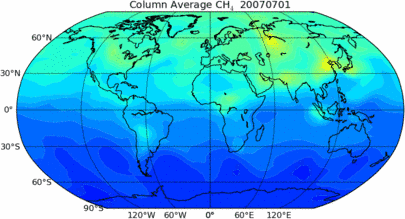Welcome! This is the premier release of the NOAA CarbonTracker-CH4 Data Assimilation Product.
It has been developed as a companion product to NOAA's CarbonTracker for CO2, with the goal of producing quantitative estimates of methane emissions into the atmosphere from natural and anthropogenic sources for North America and the rest of the world. CarbonTracker-CH4 emission estimates are consistent with observed patterns of CH4 in the atmosphere.

Methane plays an important role in the chemistry and radiative properties of the atmosphere. With a global warming potential of 28 over a 100-year horizon, methane is a potent greenhouse gas (IPCC, AR5). Atmospheric methane has a lifetime of about a decade, and it is ultimately oxidized to CO2. It is one of the greenhouse gases targeted by the Kyoto Protocol, and may well be regulated by the United States in the future. Controlling methane emissions also has implications for air quality, since oxidation of CH4 leads to tropospheric ozone formation in polluted environments.
The largest natural source of methane is microbial production in wet, anaerobic environments such as bogs, swamps, peatlands and other wetland ecosystems. Smaller amounts of methane are emitted from fires, oceans and enteric fermentation in termites and wild animals. In addition, methane is emitted in relatively small amounts from geologic sources, such as seeps, clathrates, mud volcanoes and geothermal systems. Anthropogenic sources of methane are due to a wide range of human activities, from food production (rice and livestock) to energy extraction (coal mining, leakage associated with oil and gas drilling) to waste disposal (landfills, waste water, animal waste).
The possibility of future increased CH4 emissions is a climate feedback process that is important to understand. Large stores of carbon are thought to be present in the frozen soils and permafrost of the Arctic and increased decomposition of this carbon as the climate warms may become large sources of both atmospheric methane and carbon dioxide. Systems like CarbonTracker-CH4, that merge long-term observations with best possible emission and atmospheric transport models, provide help in understanding, tracking and predicting climate feedbacks related to greenhouse gas emissions.
- Read more about how CarbonTracker-CH4 works.
- Read about the main results of CarbonTracker-CH4.
- Release Notes.
Other CarbonTrackers
- CarbonTracker-CO2 North America
- CarbonTracker-CO2 Europe
- CarbonTracker-CO2 Asia
- CarbonTracker-CO2 Australasia (under construction)
